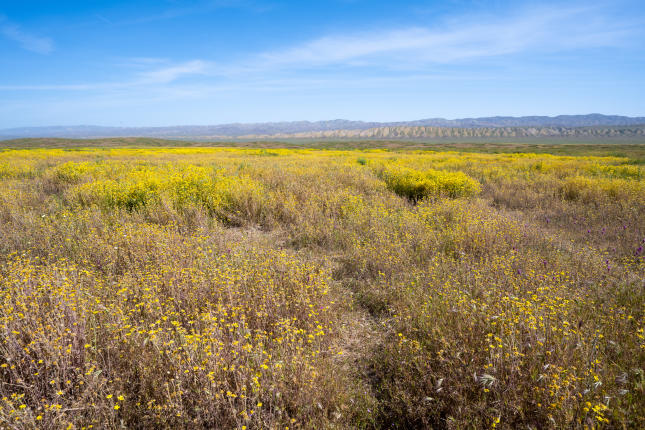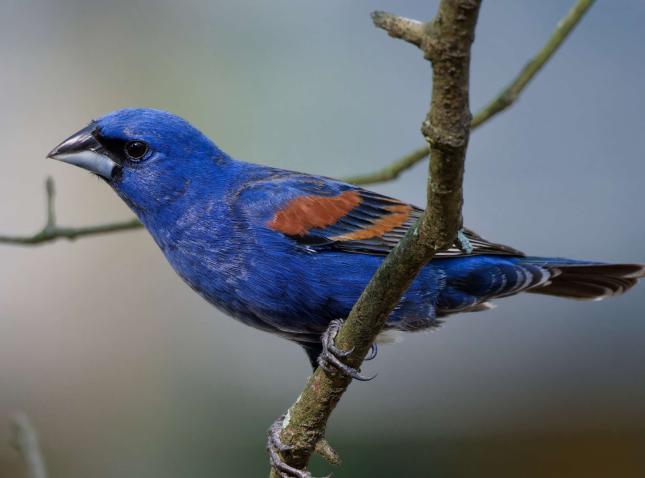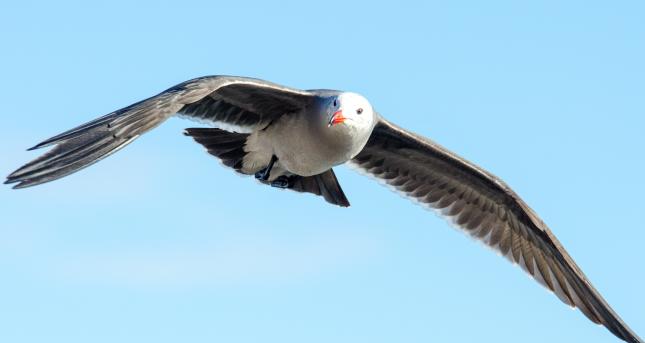August: Wild Food Banquet
 August is when the sprouts of springtime become the fruits of the fall. Birds have a veritable smorgasbord of mature native grasses, shrubs and flowers, all of which are excellent food sources. So, if the birds are not polishing off your feeders as usual, there's no cause for concern. They're eating some rare treats available only in August. They will finish off those foods quickly and be back at your feeders soon.
August is when the sprouts of springtime become the fruits of the fall. Birds have a veritable smorgasbord of mature native grasses, shrubs and flowers, all of which are excellent food sources. So, if the birds are not polishing off your feeders as usual, there's no cause for concern. They're eating some rare treats available only in August. They will finish off those foods quickly and be back at your feeders soon.
Left: Field of sunflowers on Carrizo Plain (Larry Naylor)
The earliest fall songbird migrants start to arrive this month, including the earliest fall warblers. Most of these are not going to stay, but they are exciting to see nonetheless. Yellow Warblers, with red streaks up and down their breasts always are a thrill to see. One might perch on a fruit tree, such as a fig, and take a quick bite before continuing its journey.

Grosbeaks and Orioles start heading south this month. Most of the Oriole males are gone by September, while females and young stay through mid September. Local and migrating Grosbeaks are around in September but rarely stay for the winter. The beautiful Blue Grosbeak is more often seen near Sepulveda Basin. Though called a Grosbeak, it is a bunting, related to the Lazuli Bunting.
Right: A Blue Grosbeak looks for a full feeder
The parade of House Finches coming to your feeders doesn't let up this time of year. Instead, they are bringing their you, which makes for even more traffic at the feeders. Keep plenty of No Mess handy, as they all will be hungry.
Hummingbirds, as well, are still very active, in part because they will be joined by some migrants from the desert, such as Costa's Hummingbirds, fleeing the scorching temperatures out east.
 As shorebirds sense the first hints of fall, large flocks of them, such as Cormorants, Gulls and Pelicans, pass through the area. Heermann's Gull young arrive from Mexico.
As shorebirds sense the first hints of fall, large flocks of them, such as Cormorants, Gulls and Pelicans, pass through the area. Heermann's Gull young arrive from Mexico.
Left: A Heerman's Gull Soars (Larry Naylor)
Local Sightings:
--Up to three California Condors continued to be seen along Ridge Route Road near Castaic, according to the LA Audubon.. The condors were first seen in August. The sightings are notable because condors in the past were numerous in that region.
--Purple Martins, large dark swallows sometimes confused with Starlings, have long been considered extirpated as breeders in LA County because of habitat loss. But this spring and into the summer, a string of sightings from Ballona Wetlands to Barley Flats on Angeles Crest Highway, has birders hoping that the beautiful swallow will make a comeback here. As LA Audubon noted, whether the sightings are "an aberration or a trend remains to be seen, but what a gratifying comeback it would be."
The big sky show, the Perseid Meteor Shower, hits its height on Aug. 11. However, the impact will be dampened by a full moon that day. Don't despair. The 2026 show will have no moon to dim its yearly dazzle.

